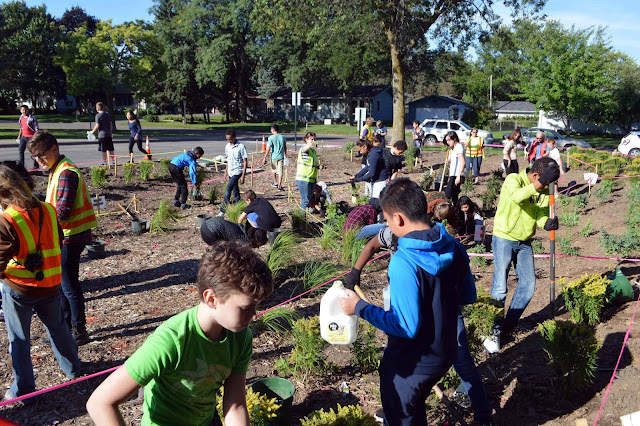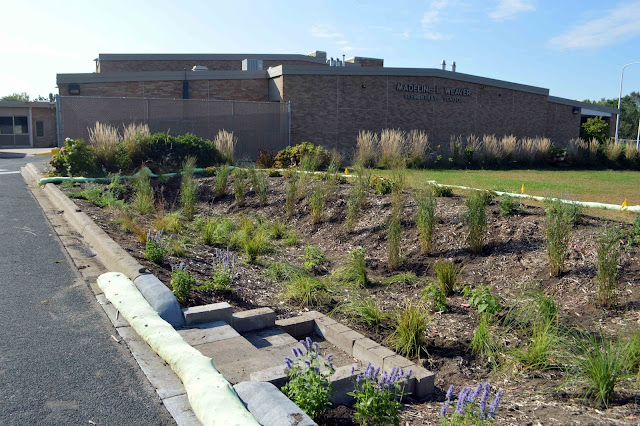Article and Photos by Sage Passi
 |
| A marathon rain garden planting at Maplewood Middle School with seventh and eighth graders |
It's early fall and we’re just about finished with our big projects at three schools in the
watershed district at Maplewood Middle School, Weaver Elementary and Harmony Learning Center. The rain garden basins are dug, classes have been involved in the planting in the last couple of weeks, the plants are in the ground doing their job and the hard physical work is almost done. Our contractor will be completing the final plantings at Maplewood Middle School in the next week or so and it will be time to celebrate!
It’s been over a two year journey to get to this step in achieving our Clean Water goal of installing large scale BMPs at schools. Along the way, we’ve had to climb a lot of hurdles. Seeing the rain gardens completed at these three schools makes it all the more gratifying to have put in such a sustained effort. Next fall we will be completing three more gardens at Central Park Elementary, Roseville Area Middle School and Woodbury Elementary School. With all the lessons learned in this round, I have confidence that we can successfully complete our commitment to engage our targeted schools in achieving reductions in stormwater runoff from their large impervious surfaces.
 |
One of three Maplewood Middle School rain gardens recently planted by students
Photo credit: Konnie Her
|
A number of years back, I wasn’t really sure it would be possible to accomplish something like this - breaking through the bureaucracy of school districts. I was very wrong. Sometimes it can be very gratifying to prove yourself wrong!
Involving the right people who have your back is essential. I couldn’t have done it without supportive engineers, a dedicated landscape architect, an encouraging watershed project manager, school district enthusiasm and some on-board teachers to back me up.

Providing the scaffolding for this initiative was the Board of Water and Soil Resources, the Clean Water Legacy Fund and our own Board of Managers who gave the green light to help fund the projects.
 |
| Barr Engineering and school district staff discuss plans in the south rain garden. |
Along the way, people gradually emerged who lent their support – from the District 622 Operations/Health & Safety Supervisor, Mike Boland, who advocated for the project to Ken Russ, the building engineer at Maplewood Middle School, who attended meetings with our technical staff and contractors and came out to provide tools and a hose, checked on our progress regularly and thanked us for our efforts when we were done.
As more people came on board, I began to have increasing confidence that, at the right moment, each of our partners would step up to the plate and help the projects come together.
Waiting in the wings to play supporting roles were our faithful partners, Maplewood Nature Center, Ramsey County Master Gardeners and Ramsey Conservation District who provided staff and volunteers for the planting event.
On the day of their planting, the Master Gardeners were there to back the classes up, but it was the kids who were the real stars.
 |
| Merlin Schlichting, Ramsey County Master Gardener, offers planting support for Weaver students. |
“I want to be a Master Gardener,” announced one of the kids as she intently planted her gallon-sized plant in the ground at Weaver Elementary School.
 |
| Digging on the berms took extra strength! |
There were some tough areas to dig into, especially along the berm of the rain garden, but the students gave it everything they had. It took both teamwork and determination to get the job done.

An important task when planting potted plants is what we refer to as ‘teasing” or loosening the roots which helps the plants become less rootbound before they go in the ground.
A Master Gardener heard a student proclaim, “I’m tenderizing the roots!”
“Teasing” the roots helps a plant recover from being rootbound, making it easier for its roots to grow into the ground.
Lessons Learned about Large Scale Plantings
 |
| Having experienced adult support was critical to the success of the project. |
 |
| Ann Hutchinson, Lead Naturalist, and her staff at Maplewood Nature Center provided expertise and equipment for the mega two- day planting at Maplewood Middle School. |
I’ve had some really good teachers when it comes to learning how to manage a planting project of this scale.
Simba, our Natural Resources Technician, has been an excellent role model through the years with all our different watershed restoration projects.
Maplewood Nature Center’s Lead Naturalist Ann Hutchinson taught me how to ask a lot of good questions when visualizing how to implement a project of this size. I drew on her and her staff’s expertise when planning for and implementing this mammoth operation.
Thank you Maplewood Nature Center for master-minding how to manage the watering of large scale projects!
Scaling Back - Making Realistic Plans
About midway through the summer, after meeting with Maplewood Nature Center staff onsite, I stood back and reassessed my initial plan to plant all three gardens at Maplewood Middle School with students. The scale of their south rain gardens in back was enormous. As I started really paying close attention to all the details and the logistics, I went back to our planning team and the contractors and came to the decision to limit our volunteer planting to the front garden.
I wanted everyone to have a quality experience and be realistic about what we could manage. When I added up the factors of weather, equipment needs, staffing and short turn-around times for each class, I knew that it was the right decision to focus on a two-day planting. In the end, eight classes at this school had the opportunity to do something hands-on to help prevent pollution downstream!
 |
| Joey Handtmann (center), watershed district permit program intern, provides directions. |
Defining clear areas for students to plant, distributing students around the planting areas and cutting down the planting time to two days made this project doable!
At Weaver, the size of the garden was much more manageable. But I had a different set of challenges: even more limited time, short shifts of fifth grade students (six rotations of 20 minutes per each half class) and only a small space to accommodate a lot of students.
 |
| Planting in 20 minute shifts - That's efficiency! |
 |
| 116 gallon pots were planted by Weaver fifth graders! |
But after completing Maplewood Middle School, I knew what to expect and we were able to pull off our planting at Weaver in two hours! It was intensive, but the kids loved it and came away proud of their accomplishments.
 |
| Harmony Learning Center rain garden |
 |
| Checking out the fragrant giant hyssop |
 |
| Investigating the inlet that brings water from the parking lot to the rain garden. |
At Harmony, we decided to involve both middle and high school students in the planting, as well as some of the adult ESL students who attend classes on the site.
It was a good opportunity to expand our message of stormwater stewardship to an adult audience.
 |
| Ramsey County Master Gardener, Kris Baird, assists a Harmony High School student in planting. |
 |
|
Adult ESL students at Harmony are experienced gardeners who work in the school's community garden They also added their touch to the rain garden. |
Teachers Take the Lead in Teaching Stormwater Engineering
EngrTEAMS is an engineering, design-based approach to teacher professional development that helps teachers design curricular units for science topic areas within the Minnesota State Academic Science Standards. Molly asked if I could offer a hands-on experience for a group of ten 4th-8th grade teachers from three school districts who would be working on developing their own integrated curriculum units.
 |
| Maplewood Earth Science Teacher Julie Cazett with RWMWD's Eric Korte and Wyatt Behrends at Maplewood Mall |
The Maplewood Mall retrofit project had recently been completed. It was a great place to demonstrate these interdisciplinary concepts. I invited Barr’s engineer, Erin Anderson Wenz and our water quality monitoring coordinator, Eric Korte to meet us out at the mall to walk the teachers through the project and explore the water quality monitoring elements on the site. Two teachers on the EngrTeam, Julie Cazett and Sara Flanagan would eventually emerge as the champions for the cause at Maplewood Middle School, one of the schools we were considering for our Clean Water projects.
The mall tour sparked their interest in examining their own site for potential locations for rain gardens and other BMPs. When I later announced to them that their schoolyard had emerged as one of the top six target sites for BMPs from our assessment process, they were absolutely delighted! In the winter I was excited to discover how intensive a unit on stormwater engineering they were teaching their eighth grade earth science classes.
Over the next year I expanded our connections with other teachers at the school and developed a relationship with the seventh grade science teachers, Mary Dvorak and Sarah Hiniker, thanks to connections made by Master Naturalist Cathy Troendle who organized field days for seventh graders at nearby Southwood Nature Preserve. Participating in the field day helped me to cement a partnership when it came time to ask them to be involved in the rain garden project.
 |
| Mary Dvorak, 7th grade science teacher, assists with planting at Maplewood Middle School. |
At Weaver, we had been working with classes for many years so it was a natural extension of our connection and Maplewood Nature Center’s ongoing collaboration with them to engage them in the rain garden project. We created lessons for the fourth graders so that when they moved up to fifth grade in the fall of this year, they would have some background and ownership of the rain garden project.
Randee Edmundson, a Citizen Advisory Commission member and an educator who has worked on watershed issues for years, had strong connections to Harmony Learning Center. She has taught there in multiple programs and helped us provide lessons for students in multiple classes.
Thank you to everyone who has made this Clean Water initiative a success!
 |
| The completed Weaver rain garden |


Thank you Sage for fabulous documentation of these community assets built together. :)
ReplyDelete